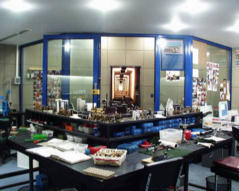

 The Accurate Reloading Forums
The Accurate Reloading Forums  THE ACCURATE RELOADING.COM FORUMS
THE ACCURATE RELOADING.COM FORUMS  Guns, Politics, Gunsmithing & Reloading
Guns, Politics, Gunsmithing & Reloading  Reloading
Reloading  Re: Using h870 powder
Re: Using h870 powderGo  | New  | Find  | Notify  | Tools  | Reply  |  |
one of us |
Frank, a few years back Richard Lee pointed out that dust from cartridge tumblers contains lead (from the primers) and was likely the major source of lead exposure to most handloaders. I don't use 'em, but if I did it'd be outside and I'd stay upwind of it whenever it was open, especially when sifting or changing media. Lead poisoning is serious business. I'm not pooh-poohing it by any means. Hot Core, I don't know what chemicals are in the Wipe Away cloths. | ||
|
| one of us |
As I recall from many years back, H870 was highly touted as the best powder for the highest velocity in the .243...I have a can of it, so probably used it for that, but I have not owned a 243 in years.....That was a caliber that never did get used to me... | |||
|
| one of us |
Exposure to lead takes the lead out of the pencil,got that from a lead smelter worker.It also makes you crazzzzzzzy,but that might be a hard one to prove. | |||
|
| Moderator |
Ricochet, as i understand it, primers, when they ARE corosive, actualy have mercury rather than lead, as mercury fulmanite is rather easy to manufactor... I hadn't known lead was the same. merc is WORSE than lead.. jeffe | |||
|
one of us |
Mercury fulminate is found in some, but not most, corrosive primers. The principle ingredient that makes corrosive primers corrosive is potassium chlorate, which is toxic itself but decomposes to potassium chloride on firing. That's nutritious to us in small quantities, but bad for steel barrels. Fulminate went out of favor for primers in the early 20th century, because it goes bad rather quickly in warm and moist storage conditions. Armies would date their ammo and rotate it out of service quickly. Nonmercuric chlorate priming compositions tend to be extremely stable, which is why the former Communist countries have continued to use them so long. They may rust bores, but they'll go bang when you want them to, every time. Most noncorrosive, nonmercuric primers are based on lead styphnate (styphnic acid being trinitroresorcinol.) They make lead oxide on firing. To reduce lead exposure in indoor ranges, unleaded primers have been introduced. They're usually based on dinitrodiazophenol. It's poisonous itself, as are most explosives, but breaks down into harmless gases and soot on firing. DNDP primers are relatively new on the market and still have a few bugs to work out to be as accurate and reliable as the styphnate primers we've been using since the '30s. (They were inferior products when they first came out, too.) | |||
|
| Moderator |
Ricochet, AWESOME,.. thanks for the facts on that!!! once again, i freely admit my data was flawed j | |||
|
one of us |
Hey jeffe, it's good to have a reminder about stuff like that. It's a bad idea to shoot lead-primed ammo in inadequately ventilated indoor spaces, but it gets done a lot. And that dust from fired cases sure does have lead in it. As does the black junk we swab out of our bores. | |||
|
| one of us |
Again, really great info. Thanks for the extra bit. I have been using a paper mask when doing large batches of brass but I am switching to a cartridge respirator as I do my shaking and cleaning inside my garage. Frank | |||
|
| Powered by Social Strata |
| Please Wait. Your request is being processed... |
|

Visit our on-line store for AR Memorabilia

